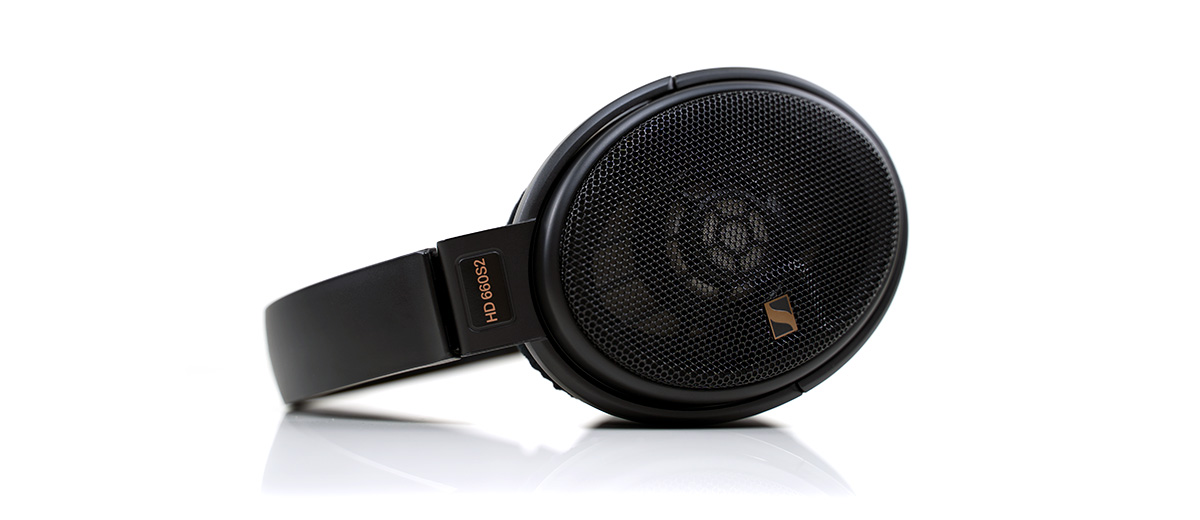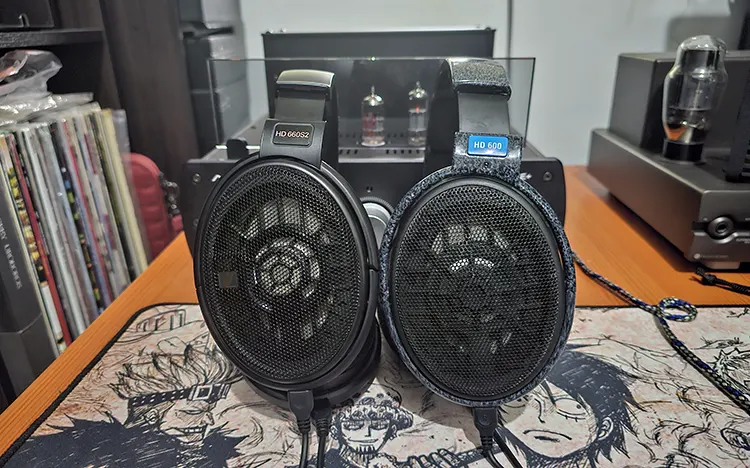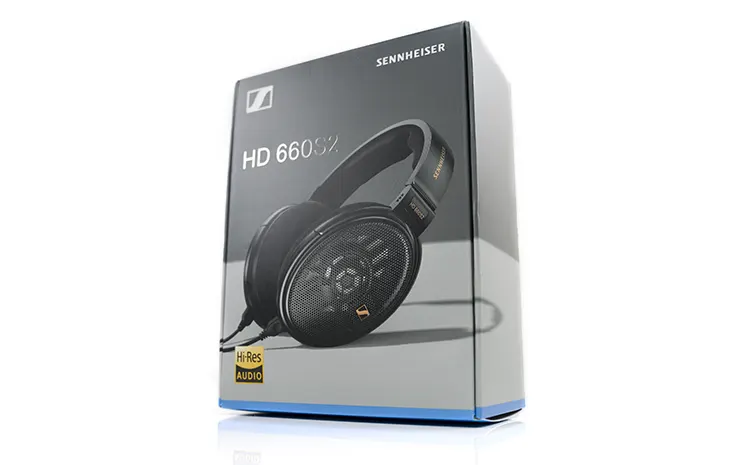Select Comparisons
For our comparisons to the HD 600S2, we used the Auris Audio HA-2SE+ and the Feliks Audio EUFORIA evo for amplification. For our source input, we used a mix of the Chord Electronics Qutest DAC and the iBasso DX320 MAX Ti balanced line out.
Sennheiser HD 660S
The HD 660S was launched in 2017 and is not a direct replacement for the older HD 600 and HD 650 series as they are still widely sold by Sennheiser.
Technical
Sennheiser basically gutted the original 42mm dynamic driver inside the HD 660S and inserted a new version with a stronger magnetic force and a reworked airflow system.
The key focus here was to really try and flesh out the HD 660S2 lows a bit more, decreasing the potential for distortion from the new driver, whilst improving the impulse response. The resonant frequency should now reside around 70Hz as opposed to 100Hz with around a 10 dB increase in presence around the 20-30Hz range.
The impedance level of the HD 660S2 has reverted to the classic 300Ω benchmark set by the HD 600 and HD 650 classics. That plays well with tube amplifiers, especially OTL owners with high output impedance PO such as the EUFORIA evo. The 150Ω rating of the HD 660S will remain an outlier in this range though again, an OTL or SETA amp meshes well.
Both of these headphones are fairly efficient with a similar SPL rating of 104 dB @1 kHz, 1Vrms. Neither will challenge your volume dial on a decent amplifier that much. It’s more the load and voltage delivery you need to get right for these two headphones to sound optimal.
Design
The changes are really quite subtle structurally with the more obvious changes in the HD 600S’s black and white decal scheme to a more low-profile bronze alternative on the HD 660S2.
The subtler changes come from the fact our HD 660S is a pre-2019/2020 Made in Ireland model which has a softer finish to the yoke and headband plastic edges. The HD 660S2 styling looks more angular and sharper when studied up close.
Sennheiser modernized a lot of the finishing on all three of their models though compared to the HD 650 and HD 600, the older HD 660S had perhaps the least amount of stylization changes.
The triple dot on the outside of the left pivot has also moved to the side pillar of the same block and I do find that a much easier location to quickly find with my finger when putting the headphones on.
The fit on both is almost exactly the same save for the chunkier memory foam on the underside of the HD 660S2 headband which does give a slightly more secure feel on my head.
I say almost at the outset because the HD 660S sample we have here is 6 years old with the original velour pads and they have softened up quite a bit compared to the fresher, stiffer, velour pads on the newer HD 660S2.
That is quite normal for the HD series pads and I expect the newer pads to soften and flatten in much the same manner as the older pads over time.
Performance
It is amazing what some additional presence at both ends of the spectrum can do for a headphone such as the HD 660S2.
Compared to the original, the HD 660S2 has more treble and bass presence, stretching the stage in terms of perceived height and depth and at the same time introducing a cleaner timbre through the mids for both vocal and instrument alike.
Though by no means a sub-bass monster, the HD 660S2 ups the 20Hz to 500Hz response curve anywhere between 10 dB at its lowest point to 1-2dB through the upper bass into the lower mids.
When it hits you can hear the difference right away compared to the original which had a nice punch but felt devoid of presence sub-100Hz. That changes the way instruments can be heard in the lower register. They now have more ‘shape and character’, better texture, and more impact as a result.
From about 6k onwards the HD 660S2 also offers a few dB more presence and that is something you can hear clearly in percussion and upper register vocal timbre. There is a bit more fizz and presence about them compared to the original tuning.
This is about what you can hear at the higher register and you can hear more here thus more perceived detail and improved articulation of that detail. It does creep down in the upper harmonic order of midrange notes also, hence a slightly cooler or more neutral tone from the HD 660S mids and not as soft or as warm sounding as the HD 600S.
Overall, the older HD 660S just sounds a bit flat on the lows and attenuated in the highs giving everything a rather narrower and clustered presentation compared to the better balance and more open sound of the HD 660S2.
Sennheiser HD 650
The Classic HD 650 was released way back in 2003, or 20 years ago and counting but did have a recent design refresh in 2020. This particular model here is the older pre-2020 model.
Technical
This particular HD 650 sample we have in the office is with the unofficially updated driver, (silver/white screen), and not the original 2004 launch version, (black screen).
It also uses a proprietary 42mm driver but it is not the same driver as HD 660S2 though it is rated at the same 300Ω impedance level making it another ideal OTL amplifier match-up.
It is also slightly less sensitive than the newer version at 103 dB @1 kHz, 1Vrms compared to 104 dB with the same weighted benchmark @1kHz 1Vrms. That might not seem much but with the impedance matched on the Auris Audio HA-2SE+, you could quickly tell the HD 650 needed a bit more juice to volume match.
You might also pick up on the rated distortion levels between these two drivers with the HD 660S2 lower at <0.04% (1 kHz, 100 dB) compared to <0.05% with the same weighting from the HD 650.
Sennheiser was also not kidding either about improving the magnetic field in the HD 660S2 assembly which is now rated at 4.5mT, (militesla), compared to the HD 650’s weaker 1.8mT rating.
Design
The form factor and weight of both of these open-back headphones are more or less the same at 260g with a neat ovoid fitting cup shape and more lateral clamp than vertical fitting pressure.
The HD 650 unit I have here is an older design though, not the newer 2019/2020 version that has a sharper edging and smaller decals but still a relatively glossy paint finish.
The older design has smoother edging and what seems to be a two-piece mold for the yoke down to the pivot hinges on the sides rather than a singular molded assembly on the newer HD 660S2.
The older design also has the bolder ‘Sennheiser’ branding on the top of the headband whereas the HD 660S2 branding is more discreetly positioned on the side of the headband in smaller bronze lettering.
The HD 650 I have here has no Sennheiser logo on the cup grills and was never introduced into the updated 2019/20 editions either.
As with the older HD 660S, the comfort and fit are relatively similar between these two headphones. The only substantial changes come with the addition of more memory foam on the underside of the HD 660S2 headband and Father Time itself.
Time and continued use will flatten those HD 650 pads giving them a more comfortable feel though some would argue it changes the sound signature a little in the process.
Performance
The HD 660S2 is a much better technical performer compared to the older HD 650 but there will still be fans of the HD 650’s overall timbre or coloration.
The clarity and response of the new driver are noticeably clearer, especially on the low-end where that lack of comparative mid-to-upper-bass amplitude on the newer tuning combined with the better sub-bass presence produces a tighter high-impact, and controlled performance.
The HD 650 is slower and softer in comparison though some would argue fuller sounding also. Yes, it does have more warmth in its bass to lower mids but it’s more pillowy in its impact, enveloping, with bloom whereas the HD 660S2 delivery has better definition. It’s a comparatively purer tone for my tastes.
Of course, there is no getting away from that warmer and smoother nature of the HD 650 mids. It’s what makes the HD 650 so easy on the ear for a wide range of musical tastes and to my ear more euphonic than the HD 660S2 equivalent.
The HD 660S2 is cooler, and more neutral in tone, with an increased level of lower treble presence largely responsible for that change in midrange coloration.
However, it is more resolving than the HD 650 through the mids, more complex in its imaging as a result, and definitely quicker-paced. You could describe it as a more aggressive and lively presentation but not quite as natural sounding as the HD 650.
Sennheiser HD 600
The oldest of the batch but probably the best known and loved, the HD 600 was launched in 1997. Similar to the HD 650, it received a design refresh in 2020. Our version in the office here is the older ‘marble’ edition.
Technical
The original HD 600 we have here had no change in the driver setup post-2019/2020 refresh which was mostly aesthetical. Both the HD 600 and HD 660S2 headphones use ultra-light aluminum voice coil designs.
Like the HD 650, the HD 600 uses an older 42mm dynamic driver with a different voice coil compared to the HD 660S2 driver design. It has a much lower magnetic field force of 1.8mT compared to the HD 660S2’s stronger 4.5mT rating.
Distortion control on the HD 660S2 is improved on paper also at <0.04%, (1 kHz, 100 dB), compared to the older HD 600 drive which is rated at < 0.1 %
Both headphones have the same 300Ω rating as the HD 660S2 but not the same level of sensitivity at a much lower 97 dB @1kHz 1Vrms SPL compared to 104 dB on the same weighted measurement scale.
That does mean the HD 600 should require a little more gain than the HD 660S2 to volume-match but working both through the Auris Audio HA-2SE+ 300Ω impedance-adjusted output I found little difference and if anything, the more mid-forward presentation of the HD 600 has a perception of enhanced loudness, (shoutier).
Design
It is crazy to think that the HD 600 first came out in 1997 and really, from afar not much has changed in terms of overall form factor with even the weight of both officially the same at 260g.
Mind you, this being the older HD 600 design you get that crazy glossy marble finish which a lot find polarizing.
I am tempted to joke that since it was made in Ireland the marble inspiration is directly lifted from someone’s local fireplace in Tullamore. Certainly, looks like my own folks’ marble surround from the living room back in the ’70s and ’80s and we were not too far away at that.
The HD 600S2 is a more sensible matte black design, with that lower profile bronze decal but it does have the shaper edging on the headband and yokes whereas the marble frame of the HD 600 is a lot smoother.
The post-2019 HD 600 design refresh does mean all the marble fund is gone so much of the noticeable differences in these two for aesthetics have disappeared save for the dash of blue on the labeling of the latest version.
The smoother curving has also been replaced by the sharper edging and single-yoke molding on the newer HD 600 which is a closer match to the HD 660S2 design.
The levels of comfort from these two headphones should equalize over time. My HD 600 pads are flat and worn out and do need to be replaced but right now, they are comfier than the HD 660S2. The newer HD 660S2 bites a little more on the sides since the pads are newer and thus firmer.
Performance
It’s all about the mids for me with the HD 600 and whilst the HD 660S2 has a very clean and clear midrange performance it’s less ‘pushed’ or with less amplitude compared to the original tuning.
For Harman enthusiasts, the HD 660 goes a little above the curve around 2-4k whereas the HD 660S2 stays on target or just below it at its highest peak.
Conversely, the HD 660S2 has a stronger response from 20Hz right up to almost 1k with 20-70hz showing much more presence and you can hear that when comparing these two headphones.
The HD 660 will create a narrower soundstage with less depth and more perceived intimacy with that stronger mid-forward tuning. The HD 660S2 is deeper sounding but more neutral through the mids but does not have as much vocal presence and is less suited to intimate performances.
It is a more balanced and dare I say it, slightly more holographic imaging presentation compared to the HD 600, at least in terms of stereo or left-right imaging it sounded a little wider and more articulate in its delivery.
Curiously, on a subjective level, I did find the HD 660S2 mids to have some subtle harmonic dissonance in vocal timbre compared to the slightly smoother equivalent performance from the HD 600.
Having said that, the HD 660S2 highs are a little more subdued through the 8-10k range compared to the HD 600. Not that the HD 600 sounds bright but you will pick up a little more energy on the very highest harmonic order in high-pitching percussion coloration compared to the smoother HD 660S2 upper-treble tuning.
Our Verdict
The Sennheiser HD 660S2 is a clear technical step up on the HD 660S. It offers superior extension on both ends of the spectrum, stretching the presentation taller and deeper and injecting some improved weight and dynamics over the original tuning. The quality of the imaging is just so much more satisfying as a result.
Tube amplifiers, particularly SETA or OTL offer the best pairing synergy and at times I found it hard to believe we are talking about sub-$500 headphones when you pair with TOTL amps like the Cayin HA-300MK2.
However, for a headphone series that has been in the wild now for 26 years, and one that many audiophiles start out with or have had for many years, inventing something new to tempt them away from the old can be a challenging process.
Some will complain that the mids lack the natural flair of the HD 650 coloration or the rounded forward presence of the often benchmarked HD 600. Others will hesitate at the price difference between the older models and the new. All fair points but aside from budgets, it’s mostly ones of personal preference.
For me, it gives me what I want or what I wish for and that was a bit of oomph from the bass and improved imaging from an HD series headphone without any bloat or aggressive treble. That allows me to take a few of the older HD models out of my listening rotation which has to be a good outcome.
Sennheiser HD 660S2 Specifications
- Transducer principle dynamic, open
- Transducer size 42mm with 38mm voice coil
- Frequency response 8 – 41,500 Hz
- Impedance 300Ω
- Sound pressure level (SPL) 104 dB (1 kHz, 1 Vrms)
- Total harmonic distortion (THD) <0.04% (1 kHz, 100 dB)
- Magnetic field 4.5mT
- Weight 260g
- Adapter 6.3 mm (1⁄4 inch) to 3.5 mm
- Connector 6.3 mm (1⁄4 inch) jack plug, 4.4 mm balanced plug
- Cable length 1.8m






